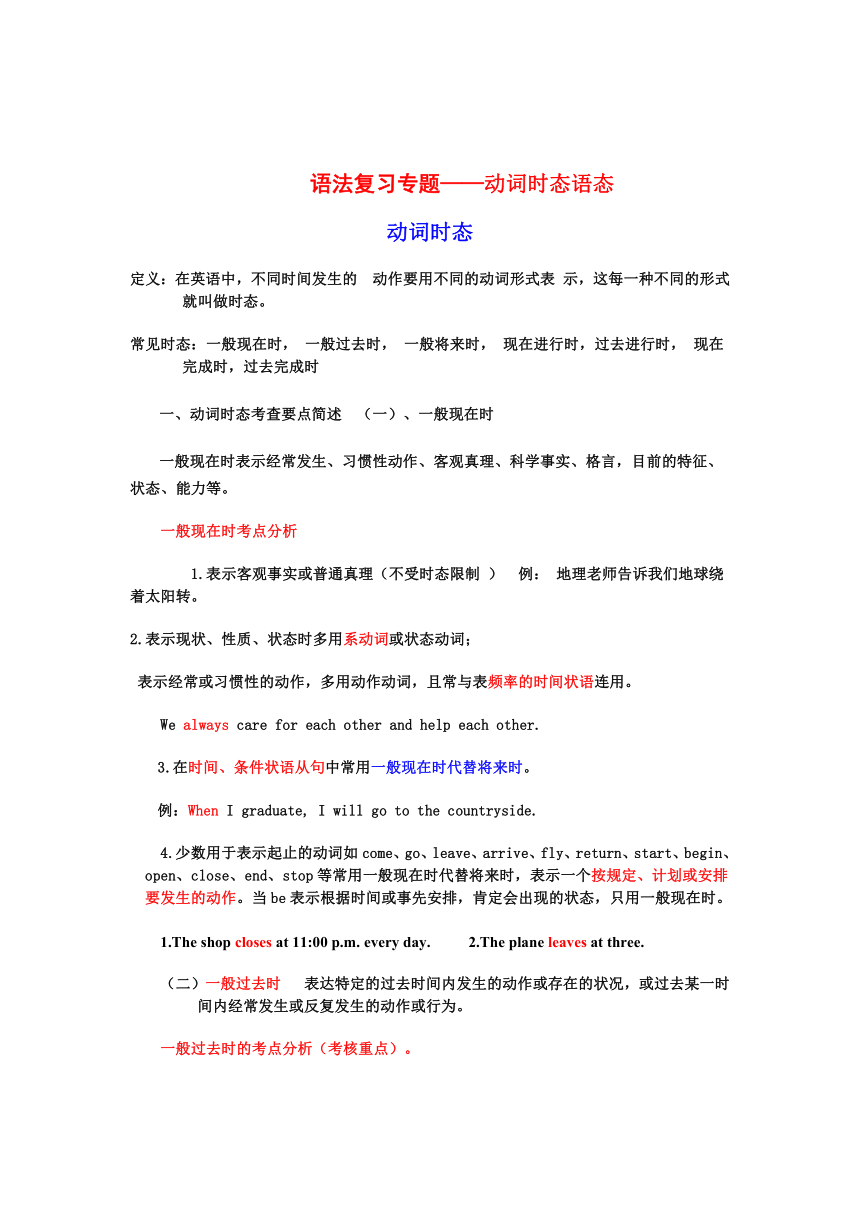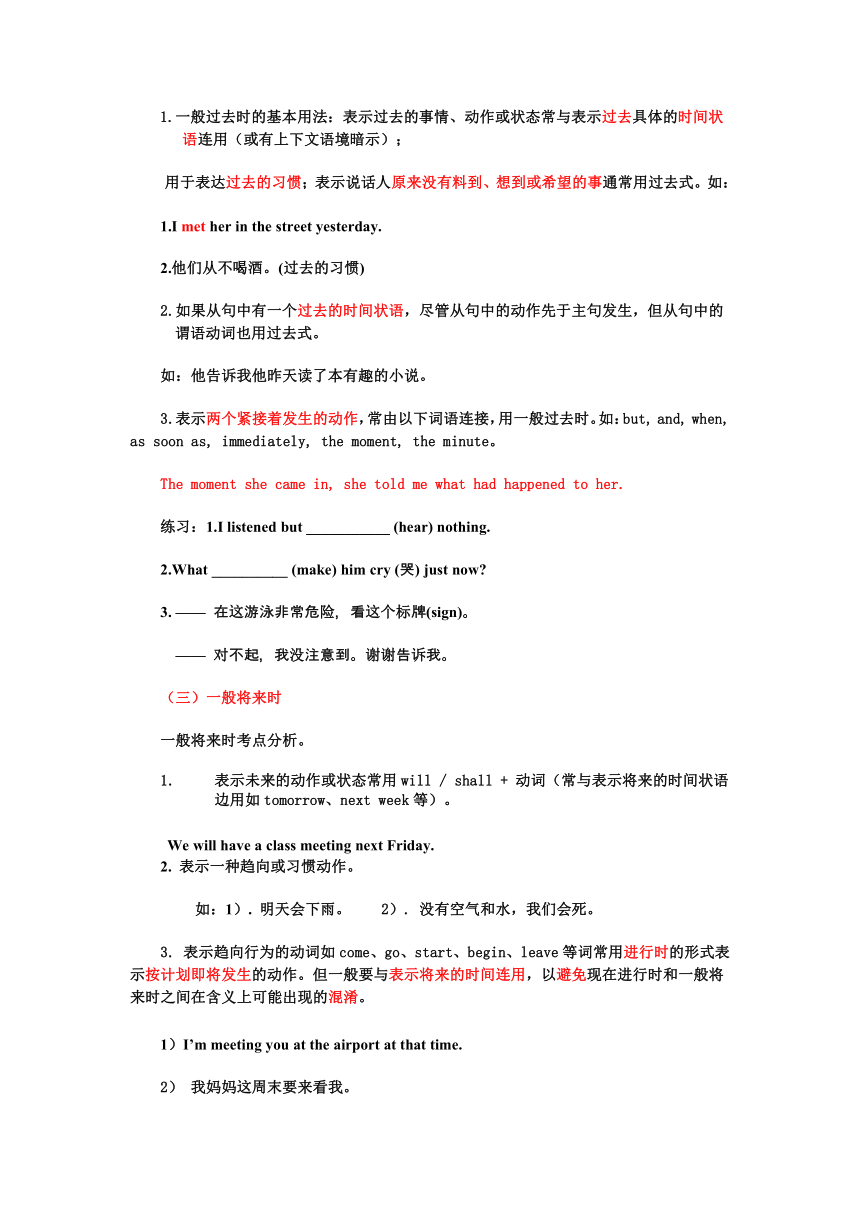动词时态语态 教案
图片预览




文档简介
语法复习专题——动词时态语态
动词时态
定义:在英语中,不同时间发生的 动作要用不同的动词形式表 示,这每一种不同的形式就叫做时态。
常见时态:一般现在时, 一般过去时, 一般将来时, 现在进行时,过去进行时, 现在完成时,过去完成时
一、动词时态考查要点简述 (一)、一般现在时
一般现在时表示经常发生、习惯性动作、客观真理、科学事实、格言,目前的特征、状态、能力等。
一般现在时考点分析
1.表示客观事实或普通真理(不受时态限制 ) 例: 地理老师告诉我们地球绕着太阳转。
2.表示现状、性质、状态时多用系动词或状态动词;
表示经常或习惯性的动作,多用动作动词,且常与表频率的时间状语连用。
We always care for each other and help each other.
3.在时间、条件状语从句中常用一般现在时代替将来时。
例:When I graduate, I will go to the countryside.
4.少数用于表示起止的动词如come、go、leave、arrive、fly、return、start、begin、open、close、end、stop等常用一般现在时代替将来时,表示一个按规定、计划或安排要发生的动作。当be表示根据时间或事先安排,肯定会出现的状态,只用一般现在时。
1.The shop closes at 11:00 p.m. every day. 2.The plane leaves at three.
(二)一般过去时 表达特定的过去时间内发生的动作或存在的状况,或过去某一时间内经常发生或反复发生的动作或行为。
一般过去时的考点分析(考核重点)。
1.一般过去时的基本用法:表示过去的事情、动作或状态常与表示过去具体的时间状语连用(或有上下文语境暗示);
用于表达过去的习惯;表示说话人原来没有料到、想到或希望的事通常用过去式。如:
1.I met her in the street yesterday.
2.他们从不喝酒。(过去的习惯)
2.如果从句中有一个过去的时间状语,尽管从句中的动作先于主句发生,但从句中的谓语动词也用过去式。
如:他告诉我他昨天读了本有趣的小说。
3.表示两个紧接着发生的动作,常由以下词语连接,用一般过去时。如:but, and, when, as soon as, immediately, the moment, the minute。
The moment she came in, she told me what had happened to her.
练习:1.I listened but ___________ (hear) nothing.
2.What __________ (make) him cry (哭) just now
3. —— 在这游泳非常危险,看这个标牌(sign)。
—— 对不起,我没注意到。谢谢告诉我。
(三)一般将来时
一般将来时考点分析。
表示未来的动作或状态常用will / shall + 动词(常与表示将来的时间状语边用如tomorrow、next week等)。
We will have a class meeting next Friday.
2. 表示一种趋向或习惯动作。
如:1). 明天会下雨。 2). 没有空气和水,我们会死。
3. 表示趋向行为的动词如come、go、start、begin、leave等词常用进行时的形式表示按计划即将发生的动作。但一般要与表示将来的时间连用,以避免现在进行时和一般将来时之间在含义上可能出现的混淆。
1)I’m meeting you at the airport at that time.
2) 我妈妈这周末要来看我。
4. 用一般现在时 ( http: / / www.21cnjy.com / " \o "欢迎登陆21世纪教育网" \t "_blank )表示将来时
A. 根据预定的日程、时间表或节目单等预计、安排或规定要发生的动作,像公交车、列车、飞机的运营,这些事情的发生往往是不可更改或不可随意更改的。(讲过)
如:We start our new term on August 30th. (文件规定)
My train leaves at six. (有严格的时间规定)
B. 在由when,before,after,as soon as,until/till引导的时间状语从句和由if,unless等引导的条件状语从句中,常用一般现在时表示将来。例如:
We aren’t leaving until he comes.
他来了我们就走。
If it rains this weekend, we won’t go out for a picnic.
5. be going to与will / shall, be to do, be about to do用法及区别:
(1) be going to 表示现在打算在最近或将来要做某事,这种打算往往经过事先考虑,甚至已做了某种准备;shall / will do表示未事先考虑过,即说话时临时作出的决定。
(2) be to do sth.表按计划、安排即将发生的动作,还可表示吩咐、命令、禁止,可能性等。
A meeting is to be held at 3:00 o’clock this afternoon.
be about to do sth.表示“即刻,就要”,意为be ready to do,后面不能接时间状语或状语从句。
Autumn harvest is about to start.
(四).现在进行时考点分析。
1.表示说话时正在发生着的一个动作(时间点);2.表示现阶段但不一定是发生在讲话时(时间段);
3.表近期特定的安排或计划;4. go、come等起止动作可用进行时代替将来时。
5.与always、often等频度副词连用,表经常反复的行动或某种感彩如:
He is teaching English and learning Chinese.
The girl is always talking loud in public.
(五).过去完成时
1. 概念 过去完成时表示在过去某一时间或动作之前已经发生或完成了的动作,即“过去的过去( past-in-the-past )”。
2. 构成 过去完成时由“助动词had + 过去分词”构成,其中 had 通用于各种人称。
3.用法
过去完成时表示某个过去动作或某个具体的过去时间之前已经发生的、完成的动作或情况。过去完成时常与after, before, when, by, hardly…when, no sooner…than(一..就, 刚…就), as soon as, until, since, for, already等连用
例如:
They had already had breakfast before they arrived at the hotel.
He didn’t go to bed until he had finished his work.
过去完成时考点分析(考核重点)。
1.常用过去完成时的几种情况:
(A)在by、by the end、by the time、until、before、since后接表示过去某一时间的短语或从句以前发生的动作。
如:
By the end of last year, we _____ (produce) 20,000 cars.
(B)表示未曾实现的希望、打算、意图、诺言等。常用had hoped / planned / meant / intended/ thought / wanted / expected等,表示 “原来…,本来…”事实没有。
I_____(intend)to call on you yesterday, but I had an unexpected visitor.
C)“时间名词 + before”在句子中作状语,谓语动词用过去完成时;“时间名词 + ago”在句中作状语,谓语动词用一般过去式。
如:He said his first teacher had died at least 10 years before.
Xiao Hua left school 3 years ago.
(六).过去将来时考点分析。
参照一般将来时对比:用would do、was / were going to do sth.表过去将来;come、go、leave等过去进行时表过去将来时;was / were to do sth.和was / were about to do sth.表过去将来。
(七)过去进行时考点分析
1.过去某一时刻正在进行的动作或某一阶段内发生或频繁发生。
2.某一动作发生时另一动作正在发生,其中一个在由when或while引导的时间状语从句中。
练习:
1. How long ___each other before they___ married
A. had they known, got B. have they known, get
C. did they know, were going to get
D. do they know, are going to get
2. By the time he was twelve, Edison _____ to
make a living by himself.
A. would begin B. has begun
C. had begun D. was begun(部分打印)
(八)现在完成时考点分析
1.现在完成时除可以和for、since引导的状语连用外,还可以和下面的介词短语连用:during / in /over the last(past)few years (months, weeks)、in recent years等。
Mary has been ill for three days.
I have lived here since 1998.
例He has _______ been to Shanghai , has he
A. already B.never C.ever D. still
2.下列句型中常用现在完成时
(1)It is (has been) + 一段时间 + since从句
It is two years since I became a postgraduate student.(研究生)
(2)This(That / It)is the first(second…)time that + 完成时
It is the first time that I have visited the city.
(3)This(that / It)is the best / finest / most interesting … + that 从句 + 完成时
This is the best film that I've (ever) seen.
3.在时间或条件状语从句中,现在完成时可以代替一般将来时。如:
If you have done the experiment, you will realize the theory better.
(九)注意几组时态的区别:
1. 一般过去时与现在完成时:时间上有差异:凡有过去时间的均用过去时态,不能用完成时态,如含有ago、last year、just now、a moment ago,等。
结果上有差异:现在完成时强调的是对“现在”的影响和结果,动作到现在刚完成或还在继续;一般过去时强调的是动作发生在“过去”,和现在毫无关系。
—These farmers have been to the United States .
—Really When ___ there
A. will they go B. did they go
C. do they go D. have they gone
2. 过去完成时与一般过去时:过去完成时强调的是“过去的过去”;如出现同一主语连续几个动作(“连谓”)形式则只用一般过去时即可。
简析:现在完成时中,非延续性动词不能与for和since引导的表示一段时间的状语连用,通常是用相应的延续性动词来代替。常用的非延续性动词及替代形式如下:
close—→be closed, put on→wear , finish/end—→be over
open—→be open get up—→be up, , become —→be ,
marry—→be married(to), borrow —→keep , go/leave-be away ,
例His father ______ the Party since 1978 .
A. joined B. has joined
C. was in D. has been in
二.被动语态
被动语态考查要点简述
(一)主动语态与被动语态:
英语动词有两种语态,即主动语态(The Active Voice)与被动语态(The Passive Voice)。
主动语态表示主语是动作的执行者; 被动语态表示主语是动作的承受者。
Cotton is grown by the farmers every year.
(二)被动语态的构成方式:be + 过去分词,口语只也有用get / become + 过去分词表示。
(三)被动语态的各种时态形式:
一般现在时态 am, is, are +过去分词 一般过去时态 was, were +过去分词
一般将来时态 will/am.is.are going to + be +过去分词
过去将来时态 would/was.were going to + be + 过去分词
现在完成时态 have, has + been +过去分词 过去完成时态 had + been +过去分词
现在进行时态 am, is, are + being +过去分词 过去进行时态 was, were + being +过去分词
含情态动词的 情态动词 + be +过去分词
(四)使用被动语态时应注意的几个问题。
一).主动变化被动时双宾语的变化。(buy, give,show, lend,pay, teach,tell,offer,leave)
An interesting book was given to me(by my friend)on my birthday.
I was given an interesting book (by my friend)on my birthday.
二)。主动变被动时,宾补成主补(位置不变);(作补语的)不定式前需加to。(let ,make, have// watch,see,look at, notice// listen to, hear, feel)
The boss made him work all day long.
He was made to work all day long(by the boss)
三)短语动词变被动语态时,勿要掉“尾巴”。( take care of,look after,listen to,speak to)
The children were taken good care of (by her).
四)。当句子的谓语为say、believe、expect、think、know、write、consider、report等时,被动语态有两种形式:(A)谓语动词用被动语态,动词不定式作主补。(B)用it作形式主语,真正的主语在后面用主语在后面用主语从句来表示。如:
1. It is said that he is a smart boy.
People say he is a smart boy. He is said to be a smart boy.
类似句型有:It is said that。 据说 It is known that 众所周知
It is suggested that据建议 It is believed that 人们相信
五)。主动形式表被动意义。
①当feel、look、smell、taste、sound等后面接形容词时;
当clean、read、sell、wear、write,wash, last(耐久),表示主语内在品质或性能的不及物动词;
当动词表示“开始、结束、关、停、转、启动”等意义时。
(begin, finish, start, open, close, stop, end, move, shut等)
This kind of cloth washes easily. My pen writes smoothly.
The door won’t lock.门锁不上。 The fish smells good.鱼闻起来香。
②当break out、take place、happen,come out, rise
shut off、turn off、work out,等动词表示“发生、关闭、制定”等意思时。
The plan worked out successfully. The lamps on the wall turn off.
③want, require, need后面的动名词用主动表示被动含义。
The children need looking after. The window wants/ requires repairing.
④be worth doing用主动形式表示被动含义。
⑤在“be + 形容词 + to do”中,不定式的逻辑宾语是句子的主语,用主动代被动。
This kind of water isn’t fit to drink.
五)被动形式表示主动意义的几种情况。
①be seated坐着 He is seated on a bench.(He seats hims
elf on a bench.)坐在凳子上。
③be lost迷路 ④be drunk喝醉 ⑤be dressed穿着 dress sb
时态语态巩固练习未打印
动词时态
定义:在英语中,不同时间发生的 动作要用不同的动词形式表 示,这每一种不同的形式就叫做时态。
常见时态:一般现在时, 一般过去时, 一般将来时, 现在进行时,过去进行时, 现在完成时,过去完成时
一、动词时态考查要点简述 (一)、一般现在时
一般现在时表示经常发生、习惯性动作、客观真理、科学事实、格言,目前的特征、状态、能力等。
一般现在时考点分析
1.表示客观事实或普通真理(不受时态限制 ) 例: 地理老师告诉我们地球绕着太阳转。
2.表示现状、性质、状态时多用系动词或状态动词;
表示经常或习惯性的动作,多用动作动词,且常与表频率的时间状语连用。
We always care for each other and help each other.
3.在时间、条件状语从句中常用一般现在时代替将来时。
例:When I graduate, I will go to the countryside.
4.少数用于表示起止的动词如come、go、leave、arrive、fly、return、start、begin、open、close、end、stop等常用一般现在时代替将来时,表示一个按规定、计划或安排要发生的动作。当be表示根据时间或事先安排,肯定会出现的状态,只用一般现在时。
1.The shop closes at 11:00 p.m. every day. 2.The plane leaves at three.
(二)一般过去时 表达特定的过去时间内发生的动作或存在的状况,或过去某一时间内经常发生或反复发生的动作或行为。
一般过去时的考点分析(考核重点)。
1.一般过去时的基本用法:表示过去的事情、动作或状态常与表示过去具体的时间状语连用(或有上下文语境暗示);
用于表达过去的习惯;表示说话人原来没有料到、想到或希望的事通常用过去式。如:
1.I met her in the street yesterday.
2.他们从不喝酒。(过去的习惯)
2.如果从句中有一个过去的时间状语,尽管从句中的动作先于主句发生,但从句中的谓语动词也用过去式。
如:他告诉我他昨天读了本有趣的小说。
3.表示两个紧接着发生的动作,常由以下词语连接,用一般过去时。如:but, and, when, as soon as, immediately, the moment, the minute。
The moment she came in, she told me what had happened to her.
练习:1.I listened but ___________ (hear) nothing.
2.What __________ (make) him cry (哭) just now
3. —— 在这游泳非常危险,看这个标牌(sign)。
—— 对不起,我没注意到。谢谢告诉我。
(三)一般将来时
一般将来时考点分析。
表示未来的动作或状态常用will / shall + 动词(常与表示将来的时间状语边用如tomorrow、next week等)。
We will have a class meeting next Friday.
2. 表示一种趋向或习惯动作。
如:1). 明天会下雨。 2). 没有空气和水,我们会死。
3. 表示趋向行为的动词如come、go、start、begin、leave等词常用进行时的形式表示按计划即将发生的动作。但一般要与表示将来的时间连用,以避免现在进行时和一般将来时之间在含义上可能出现的混淆。
1)I’m meeting you at the airport at that time.
2) 我妈妈这周末要来看我。
4. 用一般现在时 ( http: / / www.21cnjy.com / " \o "欢迎登陆21世纪教育网" \t "_blank )表示将来时
A. 根据预定的日程、时间表或节目单等预计、安排或规定要发生的动作,像公交车、列车、飞机的运营,这些事情的发生往往是不可更改或不可随意更改的。(讲过)
如:We start our new term on August 30th. (文件规定)
My train leaves at six. (有严格的时间规定)
B. 在由when,before,after,as soon as,until/till引导的时间状语从句和由if,unless等引导的条件状语从句中,常用一般现在时表示将来。例如:
We aren’t leaving until he comes.
他来了我们就走。
If it rains this weekend, we won’t go out for a picnic.
5. be going to与will / shall, be to do, be about to do用法及区别:
(1) be going to 表示现在打算在最近或将来要做某事,这种打算往往经过事先考虑,甚至已做了某种准备;shall / will do表示未事先考虑过,即说话时临时作出的决定。
(2) be to do sth.表按计划、安排即将发生的动作,还可表示吩咐、命令、禁止,可能性等。
A meeting is to be held at 3:00 o’clock this afternoon.
be about to do sth.表示“即刻,就要”,意为be ready to do,后面不能接时间状语或状语从句。
Autumn harvest is about to start.
(四).现在进行时考点分析。
1.表示说话时正在发生着的一个动作(时间点);2.表示现阶段但不一定是发生在讲话时(时间段);
3.表近期特定的安排或计划;4. go、come等起止动作可用进行时代替将来时。
5.与always、often等频度副词连用,表经常反复的行动或某种感彩如:
He is teaching English and learning Chinese.
The girl is always talking loud in public.
(五).过去完成时
1. 概念 过去完成时表示在过去某一时间或动作之前已经发生或完成了的动作,即“过去的过去( past-in-the-past )”。
2. 构成 过去完成时由“助动词had + 过去分词”构成,其中 had 通用于各种人称。
3.用法
过去完成时表示某个过去动作或某个具体的过去时间之前已经发生的、完成的动作或情况。过去完成时常与after, before, when, by, hardly…when, no sooner…than(一..就, 刚…就), as soon as, until, since, for, already等连用
例如:
They had already had breakfast before they arrived at the hotel.
He didn’t go to bed until he had finished his work.
过去完成时考点分析(考核重点)。
1.常用过去完成时的几种情况:
(A)在by、by the end、by the time、until、before、since后接表示过去某一时间的短语或从句以前发生的动作。
如:
By the end of last year, we _____ (produce) 20,000 cars.
(B)表示未曾实现的希望、打算、意图、诺言等。常用had hoped / planned / meant / intended/ thought / wanted / expected等,表示 “原来…,本来…”事实没有。
I_____(intend)to call on you yesterday, but I had an unexpected visitor.
C)“时间名词 + before”在句子中作状语,谓语动词用过去完成时;“时间名词 + ago”在句中作状语,谓语动词用一般过去式。
如:He said his first teacher had died at least 10 years before.
Xiao Hua left school 3 years ago.
(六).过去将来时考点分析。
参照一般将来时对比:用would do、was / were going to do sth.表过去将来;come、go、leave等过去进行时表过去将来时;was / were to do sth.和was / were about to do sth.表过去将来。
(七)过去进行时考点分析
1.过去某一时刻正在进行的动作或某一阶段内发生或频繁发生。
2.某一动作发生时另一动作正在发生,其中一个在由when或while引导的时间状语从句中。
练习:
1. How long ___each other before they___ married
A. had they known, got B. have they known, get
C. did they know, were going to get
D. do they know, are going to get
2. By the time he was twelve, Edison _____ to
make a living by himself.
A. would begin B. has begun
C. had begun D. was begun(部分打印)
(八)现在完成时考点分析
1.现在完成时除可以和for、since引导的状语连用外,还可以和下面的介词短语连用:during / in /over the last(past)few years (months, weeks)、in recent years等。
Mary has been ill for three days.
I have lived here since 1998.
例He has _______ been to Shanghai , has he
A. already B.never C.ever D. still
2.下列句型中常用现在完成时
(1)It is (has been) + 一段时间 + since从句
It is two years since I became a postgraduate student.(研究生)
(2)This(That / It)is the first(second…)time that + 完成时
It is the first time that I have visited the city.
(3)This(that / It)is the best / finest / most interesting … + that 从句 + 完成时
This is the best film that I've (ever) seen.
3.在时间或条件状语从句中,现在完成时可以代替一般将来时。如:
If you have done the experiment, you will realize the theory better.
(九)注意几组时态的区别:
1. 一般过去时与现在完成时:时间上有差异:凡有过去时间的均用过去时态,不能用完成时态,如含有ago、last year、just now、a moment ago,等。
结果上有差异:现在完成时强调的是对“现在”的影响和结果,动作到现在刚完成或还在继续;一般过去时强调的是动作发生在“过去”,和现在毫无关系。
—These farmers have been to the United States .
—Really When ___ there
A. will they go B. did they go
C. do they go D. have they gone
2. 过去完成时与一般过去时:过去完成时强调的是“过去的过去”;如出现同一主语连续几个动作(“连谓”)形式则只用一般过去时即可。
简析:现在完成时中,非延续性动词不能与for和since引导的表示一段时间的状语连用,通常是用相应的延续性动词来代替。常用的非延续性动词及替代形式如下:
close—→be closed, put on→wear , finish/end—→be over
open—→be open get up—→be up, , become —→be ,
marry—→be married(to), borrow —→keep , go/leave-be away ,
例His father ______ the Party since 1978 .
A. joined B. has joined
C. was in D. has been in
二.被动语态
被动语态考查要点简述
(一)主动语态与被动语态:
英语动词有两种语态,即主动语态(The Active Voice)与被动语态(The Passive Voice)。
主动语态表示主语是动作的执行者; 被动语态表示主语是动作的承受者。
Cotton is grown by the farmers every year.
(二)被动语态的构成方式:be + 过去分词,口语只也有用get / become + 过去分词表示。
(三)被动语态的各种时态形式:
一般现在时态 am, is, are +过去分词 一般过去时态 was, were +过去分词
一般将来时态 will/am.is.are going to + be +过去分词
过去将来时态 would/was.were going to + be + 过去分词
现在完成时态 have, has + been +过去分词 过去完成时态 had + been +过去分词
现在进行时态 am, is, are + being +过去分词 过去进行时态 was, were + being +过去分词
含情态动词的 情态动词 + be +过去分词
(四)使用被动语态时应注意的几个问题。
一).主动变化被动时双宾语的变化。(buy, give,show, lend,pay, teach,tell,offer,leave)
An interesting book was given to me(by my friend)on my birthday.
I was given an interesting book (by my friend)on my birthday.
二)。主动变被动时,宾补成主补(位置不变);(作补语的)不定式前需加to。(let ,make, have// watch,see,look at, notice// listen to, hear, feel)
The boss made him work all day long.
He was made to work all day long(by the boss)
三)短语动词变被动语态时,勿要掉“尾巴”。( take care of,look after,listen to,speak to)
The children were taken good care of (by her).
四)。当句子的谓语为say、believe、expect、think、know、write、consider、report等时,被动语态有两种形式:(A)谓语动词用被动语态,动词不定式作主补。(B)用it作形式主语,真正的主语在后面用主语在后面用主语从句来表示。如:
1. It is said that he is a smart boy.
People say he is a smart boy. He is said to be a smart boy.
类似句型有:It is said that。 据说 It is known that 众所周知
It is suggested that据建议 It is believed that 人们相信
五)。主动形式表被动意义。
①当feel、look、smell、taste、sound等后面接形容词时;
当clean、read、sell、wear、write,wash, last(耐久),表示主语内在品质或性能的不及物动词;
当动词表示“开始、结束、关、停、转、启动”等意义时。
(begin, finish, start, open, close, stop, end, move, shut等)
This kind of cloth washes easily. My pen writes smoothly.
The door won’t lock.门锁不上。 The fish smells good.鱼闻起来香。
②当break out、take place、happen,come out, rise
shut off、turn off、work out,等动词表示“发生、关闭、制定”等意思时。
The plan worked out successfully. The lamps on the wall turn off.
③want, require, need后面的动名词用主动表示被动含义。
The children need looking after. The window wants/ requires repairing.
④be worth doing用主动形式表示被动含义。
⑤在“be + 形容词 + to do”中,不定式的逻辑宾语是句子的主语,用主动代被动。
This kind of water isn’t fit to drink.
五)被动形式表示主动意义的几种情况。
①be seated坐着 He is seated on a bench.(He seats hims
elf on a bench.)坐在凳子上。
③be lost迷路 ④be drunk喝醉 ⑤be dressed穿着 dress sb
时态语态巩固练习未打印
